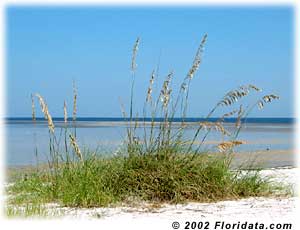Plant Profile: Sea Oats (Uniola paniculata)
 |
Figure 1. Sea oats growing along the dunes.
|
If you have ever been to a sandy beach in the state of Florida then you have likely seen sea oats. This grass can grow up to 6 ft tall and the individual grass leaves can be as big as 2 ft long and 1 in wide. Like most grasses, the leaves are long and tapered.
These grasses are extraordinarily tough. Naturally growing in coastal dunes, they thrive in the hot sands, where the top layer can reach temperatures between 120⁰ and 127⁰ F. Unlike many other dune plants, sea oats are found along the dune crest and can tolerate daily exposure to sea spray. They even can withstand hurricane winds and periods of drought. The plant has a special relationship with vesicular-arbuscular mycorrhizal (VAM) fungi. The fungi bind to the roots (in a positive way!) and thereby increase access to nutrients for a plant growing in such a challenging habitat.
These plants are important in the preservation of Florida sand dunes. Once a plant is established, their roots can be very extensive (up to 30 feet in length!). The roots and rhizomes help to stabilize shifting sands along the foredune and dune crest, thereby preventing erosion.
By helping to protect the dunes, sea oats provide habitat for many plants and the seeds are food for animals such as the federally endangered beach mouse (Peromyscus polionotus) and songbirds. The base of sand dunes is where the highly endangered sea turtles lay their eggs.
Sea oats therefore have a great environmental and economic value to the state of Florida. In fact, these plants are protected by state law. The plants are far from being endangered, but it is still illegal to pick wild sea oats, even the seeds. So please, take care of our sea oats!
Work Cited:
Barbour, M. (2000). North American Terrestrial Vegetation. Cambridge University Press.
Christman, Steve. (2004). www.floridata.com/ref/u/unio_pan.cfm. Tallahassee, Fl.
U.S. Fish and Wildlife Service.(2011). www.fws.gov/panamacity/coastal.html.
Hill, K., (2001). Smithsonian Marine Station. http://www.sms.si.edu/IRLSpec/Uniola_panicu.htm .



Comments